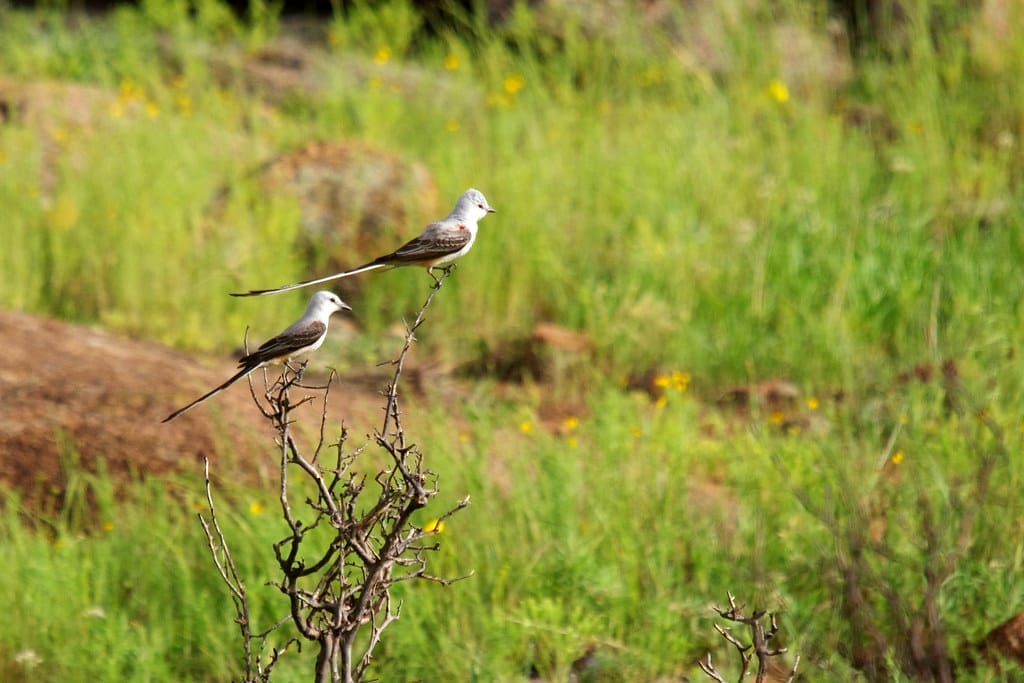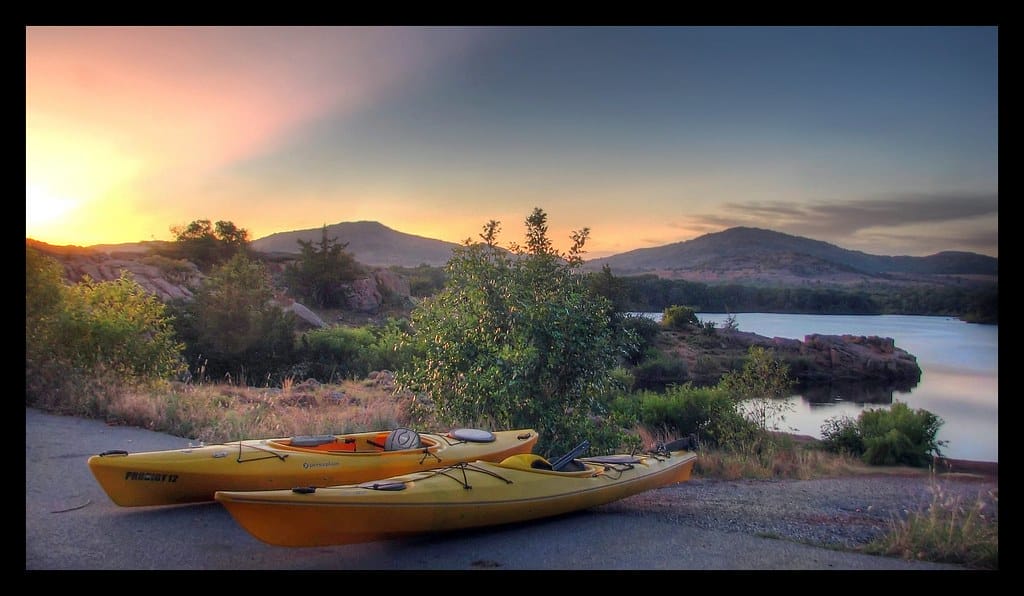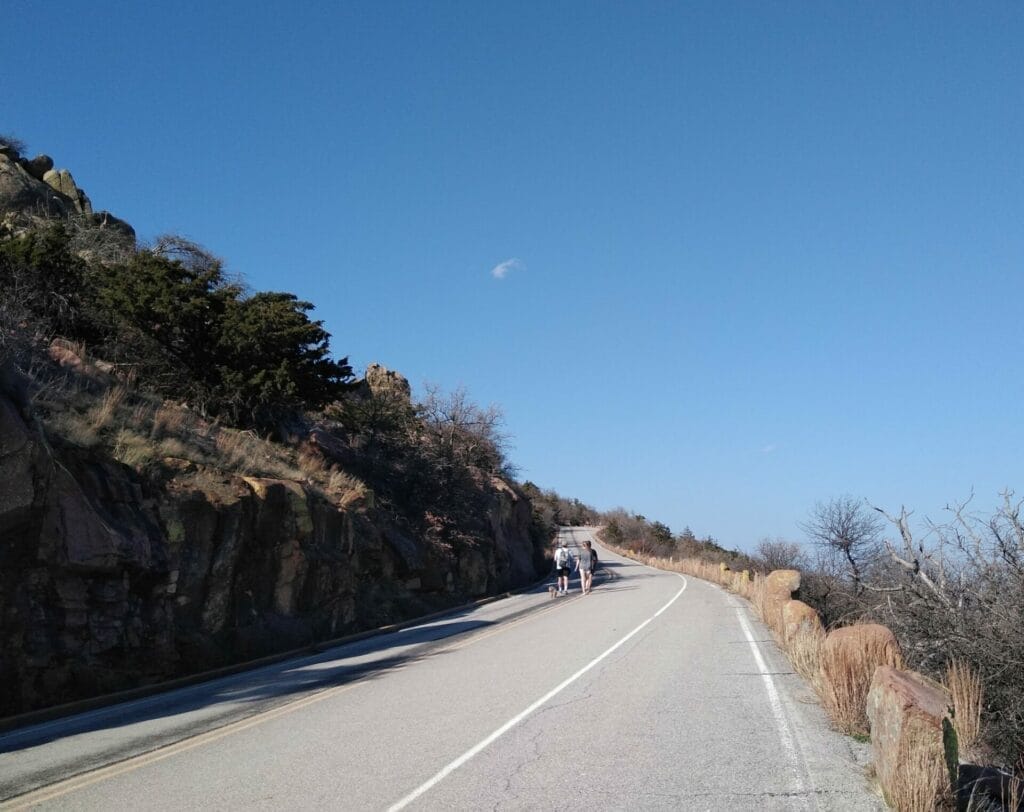Within the rugged terrain of southwestern Oklahoma lies a hidden gem of natural beauty and biodiversity: the Wichita Mountains Wildlife Refuge.
We were truly delighted by this gem.

It’s a place you wouldn’t expect much when driving into it, but it beautifully showcases Mother Nature’s magnificence in a primordial way!
Spanning over 59,000 acres, this sprawling sanctuary is a haven for wildlife enthusiasts, nature lovers, and adventurers.
It’s approximately 85 miles southwest of Oklahoma City, making this a great day out or weekend trip.
From majestic buffalo roaming the plains to elusive elk haunting the forests, the refuge has a rich variety of species.
But the refuge is more than just a haven for wildlife; it also offers history, culture, and conservation.
It is the untamed beauty of Oklahoma in its natural landscape.
I am so excited to share our journey through the Wichita Mountains Wildlife Refuge!
Share and Save this must-visit gem
Journey Through Time: History and Geology
The Wichita Mountains Wildlife Refuge is steeped in both human history and natural wonders.
Established in 1901, it is one of the oldest managed wildlife refuges in the United States.
The refuge was created to protect species that were at risk due to overhunting and habitat destruction, playing a crucial role in the recovery of the American bison, elk, and Texas longhorn cattle.

The geological history of the Wichita Mountains stretches back over 500 million years.
Formed during the Cambrian period, these ancient granite peaks were shaped by volcanic activity, erosion, and tectonic movements.
The result is a dramatic and diverse landscape that includes rocky outcrops, rolling prairies, and serene lakes, providing a variety of habitats for the refuge’s wildlife.
Wildlife Extravaganza at Wichita Mountains
Let’s get to the heart of the Wichita Mountains Wildlife Refuge: its incredible array of wildlife.
Buffalo Bonanza (or should we say Bison?)
Buffalo, also known as American bison, are one of the main attractions of the refuge.
Despite being commonly called buffalo, these majestic animals are actually bison.
They can often be seen grazing on the plains. The refuge plays a critical role in the conservation of these iconic creatures.
Because bison have so much in common with domestic cattle, pioneering ranchers on the Great Plains thought it would be worthwhile to capture and protect small herds from the hide hunters that nearly wiped them out between 1871 and 1873.
These iconic creatures, once on the brink of extinction, now roam freely thanks to the refuge’s conservation efforts.
Did you know? The bison became the official state animal of Oklahoma in 1972.

As you traverse the landscape, you may catch sight of these majestic beasts, their massive forms grazing peacefully against the backdrop of the rugged terrain.
They can often be seen grazing on the plains, particularly in the open grasslands around the Quanah Parker Lake area.
So now I wonder what the differences are between a buffalo and a bison.
Buffalo vs Bison
There are numerous differences between these animals.
The most obvious is the large hump on the back of the bison, which buffalo lack.
Bison have a massive head, but buffalo have a smaller, more “cowlike” head.
Buffalo generally live in warmer climates than bison.
The term “buffalo” is a misnomer that has been widely used since the early settlers and explorers started calling bison by that name.
True buffalo are native to Africa and Asia, such as the African buffalo and the Asian water buffalo.
American bison are distinct from these species but have been informally called buffalo for many years.
So in Wichita Mountains Wildlife Refuge, the “buffalo” are indeed American bison.
Prairie Dogs: Architects of the Prairie
Prairie dogs, with their intricate burrow systems and animated social behavior, are the architects of the prairie within the refuge.
They live in large colonies, and their burrows create a unique, dotted landscape.
There’s a strange satisfaction in watching these curious creatures pop in and out of their holes.

The best place to see them is in Prairie Dog Town along the main park roads, as well as in Holy City Prairie Town.
Listen for their chirps and calls as they echo across the plains.
And watch for their little tails wag.
Despite their diminutive size, prairie dogs play a crucial role in the ecosystem, aerating the soil, dispersing seeds, and providing food for predators.
Elk: Ghosts of the Forest
Elk, with their silent grace, are the ghosts of the forest within the Wichita Mountains Wildlife Refuge.
Though less commonly seen than their bison counterparts, these majestic creatures are no less impressive.
Although elk are less commonly seen, they are present in significant numbers.

They are usually spotted in the early morning and late evening.
The best places to look for elk are in the forested areas and meadows near Mount Scott and in the western parts of the refuge.
You may catch a glimpse of elk as they emerge from the shadows, their antlers silhouetted against the soft light of dawn or dusk.

The refuge provides a safe habitat for these large, graceful animals, ensuring that future generations will have the opportunity to witness their beauty and splendor.
White-Tailed Deer: Spirits of the Woods
The White-Tailed Deer, with their delicate movements and keen senses, are the spirits of the woods within the refuge.
These graceful creatures are a common sight and are abundant in the Wichita Mountains.
They are most active during dawn and dusk and can often be seen foraging in the woods and open fields.
Popular spots to observe them include the areas around Boulder Rooms and French Lake, as well as the wooded regions near the Holy City of the Wichitas.
White-tailed deer, known for their adaptability to various habitats, symbolize nature’s resilience as they thrive in ever-changing landscapes.
Longhorn Cattle: Living History
Longhorn cattle are descendants of the animals brought by Spanish settlers in the 1500s.
These famous animals roam freely, with their unique horns and tough appearance reflecting their long history dating back to earlier times.

They add a historical element to the wildlife experience.
As you explore the Wichita Mountains, you may encounter herds of longhorns grazing peacefully.
The best places to see longhorns are in the open fields, meadows throughout the western and central parts of the refuge.
In preserving these living relics, the refuge ensures that the legacy of the past will continue for generations to come.
Birdwatching Bliss
Birdwatchers will find over 240 species, including eagles and wild turkeys, in the Wichita Mountains Wildlife Refuge.
The diverse habitats of the refuge support the various types of birds.

Spring and fall migrations bring even more species to the area.
Prime birdwatching locations include the lakeshores of Quanah Parker Lake and Lake Jed Johnson, as well as the forested areas around Elk Mountain and Mount Scott.
The Holy City: A Step Back in Time
Stepping beyond the realm of wildlife, the Wichita Mountains Wildlife Refuge offers a fascinating glimpse into history and culture with its Holy City of the Wichitas.
A faithful 66-acre replica of ancient Jerusalem, this historic site features meticulously crafted structures that transport visitors back to Israel during Biblical times.
The Holy City is best known for its annual Easter passion play, a deeply moving reenactment that attracts visitors from all over the region.
Hitting the Trails: Adventure Awaits
For those seeking adventure on foot, the refuge offers a network of hiking trails suitable for all skill levels.
Bison Trail Trek
Among the most popular trails is the Bison Trail, favored by visitors for its moderate difficulty level and scenic vistas.
As you navigate this path, you’ll be treated to stunning views of the refuge’s diverse habitats and may even encounter some of its iconic wildlife.
Elk Mountain Adventure
For the more adventurous hikers, the Elk Mountain Trail presents an adventurous, off-the-beaten-path route that requires some navigational skills.
It’s a thrilling challenge with its steep inclines and rugged terrain.

However, the effort is richly rewarded with breathtaking views from the summit, making it a must-visit for those seeking an adrenaline-fueled adventure.
Eagle Mountain Challenge
For a challenge, Eagle Mountain, aka Boulder Mountain, involves rock scrambling and may be difficult to navigate the trail at certain points
The trail offers stunning views of the surrounding landscape, including rock formations, prairie grasslands, and diverse plant life.
You may also encounter wildlife such as deer, bison, and various bird species.
Lake Escapes: Serenity by the Water
In addition to its wildlife and hiking trails, the refuge features several serene lakes, perfect for outdoor recreation and relaxation.
Quanah Parker Lake
Quanah Parker Lake is ideal for kayakers with its tranquil waters and picturesque surroundings.

Feel nature’s embrace on this peaceful lake as you glide across the surface in a kayak.
This lake might be small and peaceful but it packs a mighty big impression.
Lake Jed Johnson
Another gem within the refuge is Lake Jed Johnson, a pristine oasis for picnicking and unwinding in the tranquil beauty of the landscape.
This serene atmosphere sets the perfect scene to indulge in “dolce far niente,” savoring the sweetness of doing nothing as you relax by the water’s edge.
Mount Scott: The Crown Jewel of Wichita Mountains
Mount Scott stands tall as the pinnacle of the Wichita Mountains Wildlife Refuge, casting its shadow over the surrounding landscape.
Rising to nearly 2,500 feet, this peak offers not only breathtaking views but also a glimpse into the geological history of the region.
Geological Wonders
The rugged beauty of Mount Scott speaks to the powerful forces that shaped the earth millions of years ago.
Composed primarily of granite, this ancient mountain provides a striking contrast to the surrounding plains.
Its weathered slopes tell a story of erosion and upheaval, offering a glimpse into the past.
Accessing the Summit
Accessing the summit of Mount Scott is relatively easy, thanks to a well-maintained road that winds its way to the top.
You can choose to drive, hike, or bike, and the journey is rewarded with unparalleled views that will leave a lasting impression.
A three-mile-long paved road leads to the summit, where there are plenty of parking spaces.
Please note the speed limit is a leisurely 25 miles an hour going up the hill.

For the safety of hikers, they have exclusive access to Mount Scott on Saturday and Sunday mornings.
Friday through Sunday, hikers must be off the mountain by noon.
Cars and bikes have exclusive access to the mountain Friday through Sunday in the afternoon.
Panoramic Views
On the top of Mount Scott, you get panoramic vistas that stretch as far as the eye can see.
From this vantage point, the vast expanse of the refuge stretches out before you, exposing a landscape of rolling hills, lush valleys, and winding rivers.



A Photographer’s Paradise
For photographers, Mount Scott is a paradise of light and shadow, offering endless opportunities to capture the beauty of nature.
Bathed in the golden hues of sunrise or silhouetted against the fiery colors of sunset, the mountain offers a stunning backdrop for capturing beautiful photographs and memories.
A Symbol of Resilience
Standing on Mount Scott, one is struck by nature’s resilience.
Despite time’s passage and the challenges it’s endured, the mountain exhibits strength and endurance.
The view of and from the mountain is inspiring from any perspective.
Final Thoughts
The beauty and nature Wichita Mountains Wildlife Refuge provides seem endless.
We have a profound appreciation for the wonders of the natural world and the importance of conservation as we leave the refuge.
From the towering peaks of Mount Scott to the tranquil shores of its serene lakes, this refuge has captured our hearts and ignited our sense of wonder.
There’s a deeper truth to our appreciation: that we are stewards of this land, entrusted with the responsibility of preserving it for future generations.
Our protection of refuges such as the Wichita Mountains Wildlife Refuge is paramount, but let’s not forget to protect our everyday environment.
We safeguard not only the diversity of life but also the very essence of our shared humanity.

So let us tread lightly, with reverence and respect, knowing that the legacy we leave behind will be measured not in years but in the countless lives touched and the lasting spirit of the wild that lives on in our hearts.
May the simple bliss of nature always be with you!
While you are in Oklahoma, make sure to visit Oklahoma City to experience its striking juxtaposition of old and new!
Resource:
Wichita Mountains Wildlife Refuge
Save and Share this must-visit gem

Photo Credits:
- “Wichita Mountains National Wildlife Refuge” by sarowen is licensed under CC BY-NC-ND 2.0 ↩︎
- “Mt. Lincoln – Wichita Mountains, Oklahoma” by Thomas Shahan 3 is licensed under CC BY 2.0 ↩︎
- “Wichita Mountains National Wildlife Refuge” by sarowen is licensed under CC BY-NC-ND 2.0 ↩︎
- “Wichita Mountains National Wildlife Refuge” by sarowen is licensed under CC BY-NC-ND 2.0 ↩︎
- “Elk @ Wichita Mountains Wildlife Refuge” by sarowen is licensed under CC BY-NC-ND 2.0 ↩︎
- “Longhorns-Wichita Mountains, OK” by duggar11 is licensed under CC BY 2.0 ↩︎
- “Wichita Mountains National Wildlife Refuge” by sarowen is licensed under CC BY-NC-ND 2.0 ↩︎
- “Quanah Parker Kayaking, Wichita Mountains, Oklahoma” by jonathanw100 is licensed under CC BY 2.0 ↩︎
- “Road up Mount Scott, OK” by James M. Branum, [blog.jmb.mx] is licensed under CC BY-SA 4.0 ↩︎



Leave a Reply